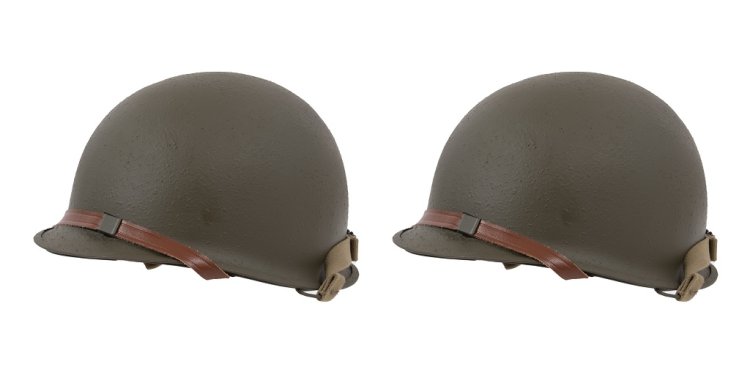About the WW2 M1 Helmet

One thing about the WW2 M1 helmet is that it didn’t just serve United States troops in the Second World War. It was issued up until 1985, when it was replaced by the PASGT, or Personnel Armor for Ground Troops helmet, which is made from 19 layers of kevlar, compared to the M1’s steel pot.
Digression aside, the WW2 M1 helmet was a considerably different design, although it did represent a serious improvement over its predecessor (more on that in a minute). The key feature of the M1 was its steel pot, which was made with non-magnetic Hadfield manganese steel.
Hadfield steel, which is sometimes referred to as mangalloy, is a manganese-rich alloy that is also rich in carbon, with between 11% and 15% of the former and 1-1.4% of the latter.
Adding manganese to steel improves the alloy by increasing its hardenability while simultaneously decreasing its brittleness. It also makes the steel tougher, more resistant to wear, and during the process of adding manganese, oxygen is displaced, resulting in a more corrosion-resistant alloy. As for carbon, it makes the steel stronger and improves its hardenability as well.
Metallurgy aside, the WW2 M1 helmet originally featured a compressed paper liner with a suspension system that was adjustable to the wearer’s head and afforded a small degree of cushioning against the pot. Eventually plastic liners were used.
As far as performance is concerned, the steel pot of the M1 was designed so that a .45 caliber bullet of 230 grains fired at 800 FPS would fail to penetrate it, providing a decent level of protection against small arms fire.
The liner of the helmet could also be worn without the steel pot, which lent the latter to a variety of other uses once removed. Apparently, it could be used as an impromptu mallet, an entrenching tool, and even, presumably in dire circumstances, as a latrine.
Apparently, the steel pots of US M1 helmets were also used to convey water and other libations. In one famous historical incident, a soldier of the 101st Airborne Division is alleged to have used his helmet to carry beer to a wounded mate during the Battle of the Bulge.
As for the finish of these helmets, during the Second World War, they were painted with a flat olive drab paint that was mixed with ground cork, producing a toothy, non-reflective surface that helped the wearer remain concealed. Sometimes soldiers also wear camouflage netting over the pot to further obscure their outlines.
In use, soldiers would commonly omit the chin strap that was integral to the helmet’s design. One of the reasons for this is that there was a pervasive myth (and fear) among servicemen that a concussive blast could lift the helmet, pulling the chin by the strap and breaking the neck.
Another reason is that, with the chin strap fastened, an enemy could sneak up from behind, pull back the helmet, thereby exposing the neck and stomach of the wearer. Therefore, soldiers often fastened the strap behind the helmet and wore it loosely, unsecured, on their heads.
To return to its origins, the M1 replaced the US M1917 helmet that was patterned after the Brodie Helmet used by the British. The issue with the latter is that while the broad, flared brim of the helmet afforded good overhead protection against shrapnel, it offered very poor protection to the sides and back of the head.
These issues were redressed by the M1, which ended up being a highly influential design that was ultimately adopted (or adapted) by many other countries.
Looking for an Original or Reproduction WW2 M1 Helmet?
Visit At The Front. They carry a number of reproduction and original WW2 M1 helmets, along with other reproduction and original helmets, including German models.
For more information about World War 2 Web Gear and World War 2 German Reproduction Uniforms please visit:- At the Front, LLC
What's Your Reaction?





















